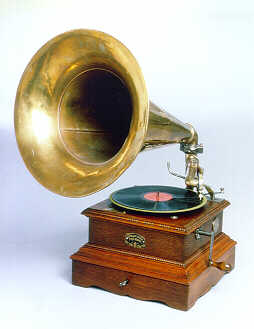
(Picture was taken from www.phonograph.com)
Tamas B. Bako - Restoration of noisy musical recordings
(this article is based on my project laboratory and
my diploma-work)

(Picture was taken from www.phonograph.com)
Tamas B. Bako - Restoration of noisy musical recordings
(this article is based on my project laboratory and
my diploma-work)
Researchers began to deal with noise reduction of musical recordings firstly in the 70's. The noise reduction subject came again into foreground when the Compact Disc appeared. CD is an excellent medium to archive musical data without quality loss. However, nobody wanted to copy directly noisy sounds to the disc. Usually a noise reduction procedure is needed in these cases.
In this article I deal with analogue and digital noise reduction techniques on gramophone recordings. First the history of gramophone will be shown. The second part talks about distortions on records. In the last two parts, some restoration methods will be discussed.
This essay is not a comprehensive scientific article. I just wanted to show some interesting things from the world of sound restoration and I tried to explain them in popular-science form.
Table of contents
1. Short history of sound-recording
2. Frequent distortion types in musical recordings
3. Physical and analogue noise reduction techniques
4. Digital noise reduction techniques
You can hear the results of a noise reduction algorithm on this 45 seconds
long sound-part. The algorithm was developed by me. The first 10 seconds
is the original noisy sound, then you can hear 10 seconds of cleaned sound,
then 10 seconds noisy sound again and finally again cleaned sound.
|
(From the Film: You are my Life) (Becce) BENIAMINO GIGLI - Tenor and the Berlin State Opera Orchestra conducted by Bruno Seidler-Winkler ORA.1406 [B.I.E.M.] HIS MASTER'S VOICE
Record manufactured by THE GRAMOPHONE CO. LTD. Hayes. Middlesex. England. (The sound was recorded in August, 1936) |
If you want, you can visit my homepage.